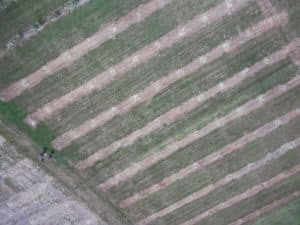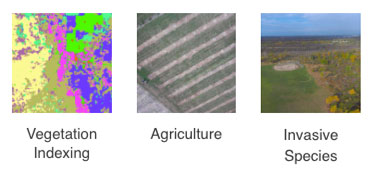Vegetation Indexing
A vegetation index is a single number that qualifies an aspect of vegetation, such as plant health or biomass, for each pixel of an image. The most common vegetation index is NDVI, which measures the presence of vegetation. NDVI is the normalized difference vegetative index and is defined as (NIR – Red)/(NIR + Red). Each pixel in an image is made of a combination of red, green, and blue light in different quantities. Healthy vegetation contains a high amount of chlorophyll, which reflects both near-infrared and green light, and absorbs blue and red light in significant amounts. Because near-infrared is not visible to the human eye, the predominant color reflected by plants is green, and that’s why they appear green. To calculate NDVI values, the quantities of near-infrared light and red light for each pixel in an image are plugged into the above formula, producing NDVI values that range from -1 to 1. When there is a high amount of near-infrared light and a low amount of red light, the NDVI value will be closer to 1, indicating a high presence of healthy vegetation.

Agriculture
 In recent years, the field of agriculture has begun to take advantage of remote sensing technology to increase crop yields with a practice known as precision agriculture. Precision agriculture is the application of precise amounts of water, fertilizer, pesticides, etc., at the correct time to the crop for increasing its productivity and maximizing its yields. NDVI is one metric used to assess crop health and pinpoint areas that require extra watering or nutrients. The aerial perspective in agriculture is helpful in a variety of ways, particularly for larger farms. Remote sensing enables farmers to more accurately calculate crop acreage, identify pest and disease infestations, make crop yield predictions, perform flood mapping, and measure soil moisture. These advancements allow for data to be captured on a larger geographic scale as well as a smaller time scale, so that changes can be made to improve the current crop. The data is also valuable for maintaining a high-quality farm record as well as improving future decision-making.
In recent years, the field of agriculture has begun to take advantage of remote sensing technology to increase crop yields with a practice known as precision agriculture. Precision agriculture is the application of precise amounts of water, fertilizer, pesticides, etc., at the correct time to the crop for increasing its productivity and maximizing its yields. NDVI is one metric used to assess crop health and pinpoint areas that require extra watering or nutrients. The aerial perspective in agriculture is helpful in a variety of ways, particularly for larger farms. Remote sensing enables farmers to more accurately calculate crop acreage, identify pest and disease infestations, make crop yield predictions, perform flood mapping, and measure soil moisture. These advancements allow for data to be captured on a larger geographic scale as well as a smaller time scale, so that changes can be made to improve the current crop. The data is also valuable for maintaining a high-quality farm record as well as improving future decision-making.
Invasive Species
Invasive species are plants or animals that are not native to a particular area but have been introduced either intentionally or unintentionally. Invasive species are well-suited to the new environments and grow rapidly, consuming and depleting the area’s natural resources that other native species rely on to survive. Through this process, invasive species disrupt the local ecosystem and cause significant damage to the native species with which they directly compete for resources, as well as to any plant or animal that relies on these native species for survival. For this reason, numerous environmental groups are interested in monitoring invasive species for scientific research and mitigation purposes.









